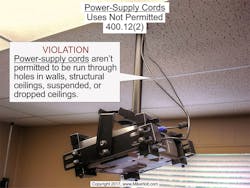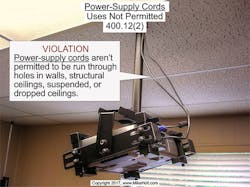Q. What is the Code rule regarding using portable cords for permanent wiring?
Find the Answer
Underlined text indicates a change in the rules for the 2017 NEC.
A. Unless specifically permitted in Sec. 400.10, flexible cords sets (extension cords) and power‑supply cords aren’t permitted for the following [400.12]:
(1) Flexible cord sets (extension cords) and power‑supply cords aren’t permitted to be a substitute for the fixed wiring of a structure.
(2) Flexible cord sets (extension cords) and power‑supply cords aren’t permitted to be run through holes in walls, structural ceilings, suspended or dropped ceilings, or floors. (Figure)
(3) Flexible cord sets (extension cords) and power‑supply cords aren’t permitted to be run through doorways, windows, or similar openings.
(4) Flexible cord sets (extension cords) and power‑supply cords aren’t permitted to be attached to building surfaces.
(5) Flexible cord sets (extension cords) and power‑supply cords aren’t permitted to be concealed by walls, floors, or ceilings, or located above suspended or dropped ceilings.
Exception to (5): Flexible cords can be located above suspended or dropped ceilings if installed in a metal enclosure in accordance with Sec. 300.22(C)(3).
(6) Flexible cord sets (extension cords) and power‑supply cords aren’t permitted to be installed in raceways, except as permitted by Sec. 400.17 for industrial establishments where the conditions of maintenance and supervision ensure that only qualified persons will service the installation.
(7) Flexible cord sets (extension cords) and power‑supply cords aren’t permitted where they’re subject to physical damage.
Even cords listed as “extra‑hard usage” must not be used where subject to physical damage.
About the Author

Mike Holt
Mike Holt is the owner of Mike Holt Enterprises (www.MikeHolt.com), one of the largest electrical publishers in the United States. He earned a master's degree in the Business Administration Program (MBA) from the University of Miami. He earned his reputation as a National Electrical Code (NEC) expert by working his way up through the electrical trade. Formally a construction editor for two different trade publications, Mike started his career as an apprentice electrician and eventually became a master electrician, an electrical inspector, a contractor, and an educator. Mike has taught more than 1,000 classes on 30 different electrical-related subjects — ranging from alarm installations to exam preparation and voltage drop calculations. He continues to produce seminars, videos, books, and online training for the trade as well as contribute monthly Code content to EC&M magazine.


